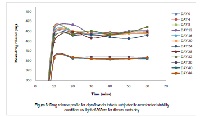Effect of sunlight, moisture, temperature and ultraviolet radiation on the quality control parameters of ciprofloxacin tablet formulation
Keywords:
Accelerated Stability Conditions, Stability, Quality, Ciprofloxacin Hydrochloride, TabletsAbstract
This work assesses the stability and quality of Ciprofloxacin hydrochloride tablets after subjection to accelerated stability conditions of sunlight, temperature of 40±10C, 75% relative humidity, and UV light of 365 nm for 4 hours each day. This study was performed at time zero and at 4-day intervals for a period of 45 days (that is, days 0, 4, 8, 12…40, 44) according to the International Conference on Harmonization (ICH) accelerated aging conditions and the results obtained were subjected to statistical analysis. The results showed that with increasing time there was a gradual reduction in the dissolution rate with the tablets exposed to all four storage conditions failing the test on day 44 where they had less than 80 % release of the label claim. For content of Ciprofloxacin Hydrochloride, only those tablets exposed to UV light passed the test for all 44 days as they had a minimum of 96.83 % content on the 44th day. At day 0, all the tablets assayed passed this test, having a ciprofloxacin content of 99.43 %. For those tablets subjected to the other storage conditions including temperature of 40±10C, 75 % relative humidity and sunlight, they had ciprofloxacin content of 70.22 %, 71.50 %, and 78.36 % respectively. The results further, indicated that the storage conditions used in the study had a greater impact on the dissolution behavior and content of the Ciprofloxacin tablets than they did on the physical stability (hardness, uniformity of weight, disintegration).
References
The American Society of Health System Pharmacists: “Ciprofloxacin Hydrochloride” (Retrieved 23rd August 2015)
Osonwa Uduma E., Agboke Ayodeyi A., Amadi Rosemary C, Okorie Ogbonna, and Opurim Christin C: Bioequivalence studies on some selected brands of Ciprofloxacin Hydrochloride tablets in the Nigerian market; Journal of Applied Pharmaceutical Science 01(06); 2011: 80-
M Jaman, A. A. Chowdhury, A. A. Rana, S. M. Masu: In vitro Evaluation of Ciprofloxacin Hydrochloride; Bangledash Journal of Scientific and Industrial Research 50(40), 251-256, 2015
Ranga Priya M, Sellakumar V, Natarajan R and Mohan Kumar K: Formulation and In vitro Evaluation of Ciprofloxacin Loaded Topical Emulgel; International Journal of Pharmaceutical and Chemical Sciences Vol. 1(1), pp 237-242, Jan-Mar 2012
B. K. Poudel, P. Thapa: In vitro interactions of Ciprofloxacin with selected drugs and excipients; Kathmandu University Journal of Science, Engineering and Technology Vol 9, No 1. July 2013, pp 1-14
Edith Cristina Laignier Caze de y, Hé rida Regina, Nunes Salgado; School of Pharmaceutical Sciences, Sao Paulo State University, Araraquara, Sao Paulo, Brazil: Advances in Analytical Chemistry 2012,2 (6): pp 74-
Ofoefule S. I: A Textbook of Pharmaceutical Technology and Industrial Pharmacy, Samakun Nigeria Enterprises 2002, pp 120-125
The United States Pharmacopoeia. United Pharmacopoeia Convention Inc; Rockville, MD, 2005
Mirza Shahed Barg and M.H.G Dehghan: Effect of accelerated aging conditions on in vitro dissolution studies of moxifloxacin hydrochloride and cefixime trihydrate from its combined dosage form by HPLC assay methods; World Journal of Pharmacy and Pharmaceutical Science, 2015
The British Pharmacopoeia 2012, Volume I, pp 526-527.






